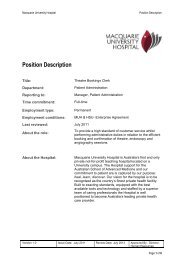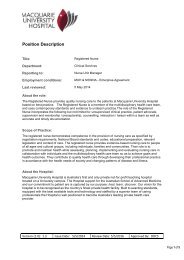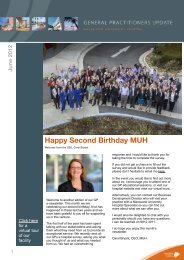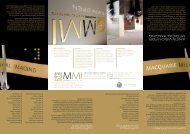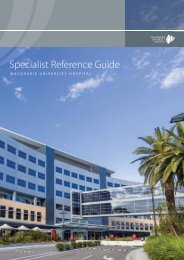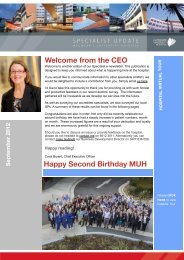Plenary Oral Presentations - Macquarie University Hospital
Plenary Oral Presentations - Macquarie University Hospital
Plenary Oral Presentations - Macquarie University Hospital
Create successful ePaper yourself
Turn your PDF publications into a flip-book with our unique Google optimized e-Paper software.
16 th International Meeting of the Leksell Gamma Knife ® SocietyMarch 2012, Sydney, AustraliaMA-173Malignant transformation of low-grade meningiomato high-grade gliosarcoma, six years after gamma kniferadiosurgeryLeon Liem, Brita Cheng<strong>University</strong> of Hawaii, John A. Burns School of Medicine, Honolulu, HIObjective: Gliosarcoma is a rare variant of glioblastoma multiforme. Radiation-induced gliosarcomais rare having been reported in few patients, usually involving high radiation dosages for treatment ofa primary malignancy. Here we report a case in which a patient received single fraction gamma kniferadiosurgery for a confirmed low-grade meningioma and subsequently developed a gliosarcoma sixyears later.Methods: A 50-year-old female presents with progressive confusion, expressive aphasia, right-sidedweakness and ataxia. MRI imaging revealed a very large enhancing mass involving the left lateralventricle and adjacent temporal lobe with extension into the quadrigeminal plate region. The patientunderwent a left parietal craniotomy and a subtotal resection with residual tumor close to thebrainstem. Pathology revealed a well-differentiated meningioma (WHO grade I). The patient receivedpostoperative gamma knife radiosurgery to the residual tumor (14 Gy to the 50% isodose line, tumorvolume 3.4cc with 100% coverage). Yearly MRI imaging revealed stable tumor size with no newsymptomatology.Results: Six years after initial presentation, the patient developed gradual reoccurrence of priorsymptoms and new onset diplopia. MRI imaging revealed an interval increase in tumor mass size withsuperior and inferior extension on the left side of the tentorium, suggestive of recurrent meningioma.The patient underwent a left temporoparietal craniotomy and a subtotal resection with residualinfratentorial tumor. Pathology revealed gliosarcoma (WHO Grade IV) and residual meningioma withradiation-induced changes. The patient declined neurologically and expired 8 months after symptomreoccurrence despite aggressive treatments.Conclusions: Although radiation induced malignancies are well documented, the induction ofmalignant tumors after gamma knife radiosurgery is extremely rare. This case of the developmentof a gliosarcoma after gamma knife radiosurgery for meningioma points out that malignanttransformation is a rare but real concern in the treatment of benign disease.42



